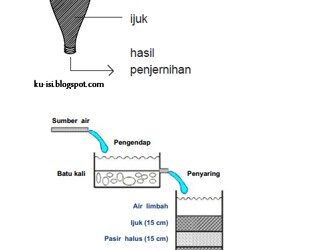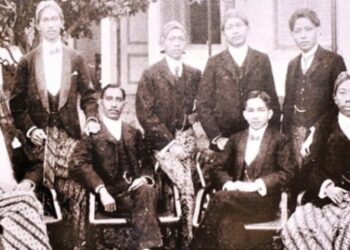CRAFTS OF HYACINTH WATER PLANT
| Name | : Zainul Khasan |
| NIS/NISN | : 170742 |
| Study program | : Natural Sciences |
Madrasah Aliyah Al Ahrom Karangsari
ACCREDITED – B
CHAPTER I INTRODUCTION TO THE RESEARCH
A. Research Background
Water hyacinth (Eichhornia crassipes) was originally imported from the Americas when British Governor-General Stamford Raffles was to fill the collection of plants in the Bogor Botanical Gardens he made. As an aquatic plant, this water hyacinth has very beautiful flowers, so it is called water hyacinth.
From Bogor, Water Hyacinth spread throughout Indonesia, even having its local name in certain areas. Water Hyacinth plants massively dominate the waters and become weeds everywhere. After knowing that Water Hyacinth has a high cellulose content, many people began to look at this weed as a raw material for handicrafts which is quite interesting. Water Hyacinth is now widely hunted to be used as raw material for woven, household furniture such as chairs and various others can be made from Water Hyacinth depending on human creativity (CREATIVITY).
An example of how to make this simple natural craft into an interesting handmade product that can be profitable, [+] how to process Water Hyacinth from nuisance weeds that can be used as woven raw materials are as follows:
- The material for woven crafts is only the leaf stalks. Other plant parts, namely roots, leaves, shoots, and flowers, are made. Water Hyacinth leaves can be used for compost or fodder.
- Water Hyacinth stalks are cleaned with clean water (can).
- Drying is done on the floor surface (approximately seven days). First, the drying will be faster by first removing the water content by pressing manually.
- The dried stalks can be sliced into smaller pieces.
The content and benefits of Water Hyacinth, elements of SiO2, calcium (Ca), magnesium (Mg), potassium (K), sodium (Na), chloride (Cl), copper (Cu), manganese (Mn), ferrum (Fe) and much more. The roots contain sulfate and phosphate compounds. The leaves are rich in carotene compounds, and the flowers contain delphinidin-3-diglucoside. Water hyacinth can cure a sore throat, urinary incontinence, hives, and ulcers with all the existing chemical content. The content of these important compounds found in all plant organs, from roots to leaves, can be used as ingredients for traditional medicine. Even the charming flowers are also good for traditional medicine.
B. Problem Finding
- What is the meaning of the Water Hyacinth plant?
- How is the process of processing crafts from Water Hyacinth?
- What are the benefits of the Water Hyacinth plant?
C. Research Objectives
- To know the meaning of Water Hyacinth,
- To know the process of processing handicrafts from Water Hyacinth,
- To find out the benefits of Water Hyacinth plants for crafts.
D. Benefits of Writing
- Water Hyacinth leaves, stems, and flowers can be positioned for fodder,
- Water Hyacinth flowers can be used as ingredients for traditional medicine,
- Water Hyacinth plants can be used as woven crafts.
CHAPTER II RESEARCH OF WATER HYACINTH
Theoretical Foundations
According to Cheryl (2000), empowerment is the idea of power. The possibility of empowerment depends on two things. First, empowerment requires power to change (power can change). If empowerment does not have the power to change and is inherent in the community, empowerment will not be possible. Second, the concept of empowerment relies on the ability to develop Water Hyacinth plants. In Cheryl (2000), Baily explains that empowerment is a multi-dimensional social process that helps people gain control over their own lives. Furthermore, it is explained that empowerment has three basic components, namely:
- Empowerment is multi-dimensional, which means it can be related to social, psychological, economic, and other fields.
- Empowerment is social, which means that empowerment pays attention to various societal levels, such as individuals, groups, and communities.
- Empowerment is a process that means that in the implementation of empowerment, there is a relationship with other people. Empowerment in this concept can mean that it is a continuous process.
Based on the concept of empowerment described, the empowerment of water hyacinth becomes a continuous process that will later contribute to the community.
Classification of Water Hyacinth
Water Hyacinth classification, according to Van Steenis (1978), is as follows:
Kingdom : Plantae
Sub kingdom : Tracheobionta
Super Division : Spermatophyta
Division : Magnoliophyta
Class : Liliopsida
Order : Alismatales
Family : Butomaceae
Genus : Eichornia
Species : Eichornia crassipes solms
This plant has a fast regeneration power because the vegetative pieces carried by the current will continue to develop into an adult Water Hyacinth. Water Hyacinth is very tolerant of conditions where the nutrients in the water are not sufficient, but its response to high nutrient levels is also great.
Water Hyacinth has two ways to reproduce: seeds and shoots above the shoot roots creeping up and out of the leaf area that can grow to become plants ranging from 20ºC, ideal temperature, with acidity (pH) between 4-12. In clear and very deep water, especially on high land (more than 1,600 m above sea level), Water Hyacinth is difficult to grow and develop.
Vegetative reproduction can double in 7-10 days. Impact control agency research results (environment reports that one stem of Water Hyacinth).
What is Water Hyacinth (Eichornia Crassipes)
Water Hyacinth spreads worldwide and plants at altitudes ranging from 0-1,600 m above sea level in cold climates. The spread of this plant can be through canals, rivers, lakes, swamps, and other freshwater with a slow flow.
In Indonesia, Water Hyacinth was originally introduced by the Bogor Botanical Gardens in 1894, which eventually developed in the Ciliwung River as a nuisance plant. Water Hyacinth is a floating herb, sometimes giving birth in the soil, producing creeping shoots that come out of the leaf axils, which can grow again into new plants with a height of 0.4 – 0.8 m. This plant has a physical form in the form of leaves. Leaves arranged in a radical form (rosette) on each stalk on the mature leaf blade are short and wrinkled. The leaf blade (lamina) is broadly oval with tightly curved leaf bones, 7-25 cm long, bald, and the color of the leaves is shiny green.
Water Hyacinth is a problem that has never been resolved, apart from blocking the flow of water, which results in flooding. Water Hyacinth also inhibits the farmers in the lake. However, in limited conditions, Water Hyacinth can improve water quality. Still, when the population is above normal, it can be detrimental that water hyacinth causes a lot of pollution problems in rivers and reservoirs, but has benefits, including:
- Has biological properties as a filter for water polluted by various industrial waste chemicals.
- As a soil cover material (mulch) and compost in agricultural and plantation activities.
- As a gas source, among others, in ammonium sulfate gas, hydrogen gas, nitrogen, and methane can be obtained by fermentation.
- Plant fertilizer raw materials contain NPK elements which are the three main elements needed by plants.
- As raw material for activated carbon.
- As an industrial material for paper and artificial boards.
- As a material for the craft industry.
Water Hyacinth can be made for plant fertilizers that contain NPK elements and are the three main elements needed by plants for handicrafts. Water Hyacinth can be made into paper and board manufacturing and handicraft industries. The results of laboratory studies show that Water Hyacinth can bind metal elements in water because it is only suitable for living in dirty water compared to clean water. The leaves can be used as animal feed ingredients, from the stem fiber used in handicrafts.
Benefits of Water Hyacinth Woven Crafts
Weaving is an art that influences the life and culture of the Malay community. Weaving means the process of netting or crossing materials from plants to form a strong and usable clump. Weaving is one of the oldest traditional arts in the world. It is said that this activity was imitated by humans from the way birds weave branches into one strong form. The art of weaving also exists in various Indonesian cultures. It is empowering as raw material and the expected alternative solutions to overcome the approach.
Water Hyacinth Nutritional Content
Water Hyacinth is a food ingredient commonly consumed by the public. Water Hyacinth contains 18 kilocalories of energy, 1 gram of protein, 3.8 grams of carbohydrates, 0.2 grams of fat, 80 milligrams of calcium, 45 milligrams of phosphorus, and 4 milligrams of iron. In addition, Water Hyacinth contains 1000 IU of vitamin A, 0.08 milligrams of vitamin B1, and 50 milligrams of vitamin C. Water Hyacinth Nutritional obtained these results from researching 100 grams of Water Hyacinth, with an edible amount of 70%.
Benefits of Water Hyacinth Plants
Leaf – Water Hyacinth leaves can be used as an ulcer medicine. Gastritis is caused by a very high level of stomach acidity, and water Hyacinth boiled water turns out to neutralize stomach acid. There are natural compounds in Water Hyacinth that can reduce high acidity levels in the stomach.
Stem – The stems of the Water Hyacinth plant are usually useful as woven crafts such as bags and belts. But this is not the only benefit of this plant that is often considered a weed. Water Hyacinth stems are also very useful for body health; Water Hyacinth stems contain potassium, calcium, magnesium, SiO2, chloride, copper, and ferrum, which are useful for the body.
Root – Water Hyacinth has thick roots whose function is to maintain the balance of Water Hyacinth. It does not turn around when it floats in water; Water Hyacinth roots can also perform root functions in general, namely to absorb food substances and nutrients needed by plants and water.
CHAPTER III RESEARCH CLOSING
Conclusion
Water Hyacinth is a plant that is easy to cultivate. According to Cheryl (2000), empowerment is the idea of power, and the possibility of empowerment depends on two things. In Cheryl (2000), Baily explains that empowerment is a multi-dimensional social process that helps people gain control over their own lives.
Water Hyacinth plants were originally imported from the Americas at the British Governor-General. As an aquatic plant, Water Hyacinth has very beautiful flowers, so it is called water hyacinth. Water Hyacinth plants still dominate the waters and become weeds everywhere after it is known that Water Hyacinth has a high solvency level.
Water Hyacinth is now being hunted a lot to be used as raw material for woven, household furniture such as chairs and other things, can be made and Water Hyacinth depending on creativity. Creativity or crafts from Water Hyacinth can benefit the community.
Suggestion
I, as the author, realize that it is still far from perfect, and of course, there are many shortcomings in making this scientific paper. I hope for criticism and suggestions, and I will give suggestions that might provide input for consumers and the community, namely to find out the various benefits of Water Hyacinth plants or grow -other plants.
BIBLIOGRAPHY
Fadholi, A. 2009. Kerajinan Water Hyacinth. ariffadhosi blogspot , diakses 07 Januari 2020)
Galerivilm. 2010. Bisnis Kerajinan Water Hyacinth. galerivilm website, 07 Januari 2020)
sunarjono, Hendro. 2011. Water Hyacinth & Kerajinan. Jakarta : Penebar Swadaya













